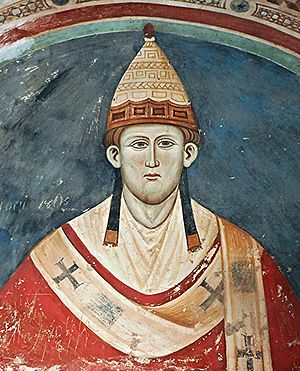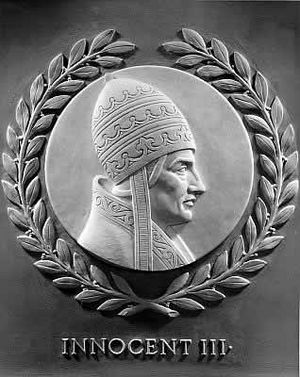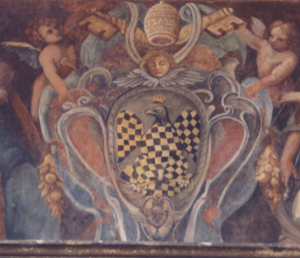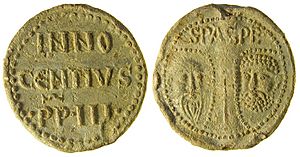Pope Innocent III facts for kids
Quick facts for kids Pope Innocent III |
|
|---|---|
| Bishop of Rome | |

Detail of a fresco at the cloister Sacro Speco, c. 1219
|
|
| Church | Catholic Church |
| Papacy began | 8 January 1198 |
| Papacy ended | 16 July 1216 |
| Predecessor | Celestine III |
| Successor | Honorius III |
| Orders | |
| Ordination | 21 February 1198 |
| Consecration | 22 February 1198 by Ottaviano di Paoli |
| Created Cardinal | September 1190 |
| Personal details | |
| Birth name | Lotario de' Conti di Segni |
| Born | 22 February 1161 Gavignano, Papal States |
| Died | 16 July 1216 (aged 55) Perugia, Papal States |
| Nationality | Italian |
| Parents | Count Trasimund of Segni and Claricia Scotti |
| Previous post |
|
| Other Popes named Innocent | |
Pope Innocent III (Latin: Innocentius III; 22 February 1161 – 16 July 1216), born Lotario dei Conti di Segni (anglicized as Lothar of Segni), was the head of the Catholic Church and ruler of the Papal States from 8 January 1198 until his death on 16 July 1216.
Pope Innocent was one of the most powerful and influential of the medieval popes. He exerted a wide influence over the Christian states of Europe, claiming supremacy over all of Europe's kings. He was central in supporting the Catholic Church's reforms of ecclesiastical affairs through his decretals and the Fourth Lateran Council. This resulted in a considerable refinement of Western canon law. He is furthermore notable for using interdict and other censures to compel princes to obey his decisions, although these measures were not uniformly successful.
Innocent greatly extended the scope of the Crusades, directing crusades against Muslim Iberia and the Holy Land as well as the Albigensian Crusade against the Cathars in southern France. He organized the Fourth Crusade of 1202–1204, which ended in the sack of Constantinople. Although the attack on Constantinople went against his explicit orders, and the Crusaders were subsequently excommunicated, Innocent reluctantly accepted this result, seeing it as the will of God to reunite the Latin and Eastern Orthodox Churches. In the event, the sack of Constantinople and the subsequent period of Frankokratia heightened the hostility between the Latin and Greek churches; the Byzantine Empire was restored in 1261, albeit much weaker.
Contents
Biography
Early life
Lotario de' Conti was born in Gavignano, Italy, near Anagni. His father, Count Trasimondo of Segni, was a member of a famous house, the Conti di Segni (Counts of Segni), which produced nine popes, including Gregory IX, Alexander IV and Innocent XIII. Lotario was the nephew of Pope Clement III; his mother, Clarissa Scotti (Romani de Scotti), was from the same noble Roman family.
Lotario received his early education in Rome, probably at the Benedictine abbey of St Andrea al Celio, under Peter Ismael; he studied theology in Paris under the theologians Peter of Poitiers, Melior of Pisa, and Peter of Corbeil, and (possibly) jurisprudence in Bologna, according to the Gesta (between 1187 and 1189). As pope, Lotario was to play a major role in the shaping of canon law through conciliar canons and decretal letters.
Shortly after the death of Alexander III (30 August 1181) Lotario returned to Rome and held various ecclesiastical offices during the short reigns of Lucius III, Urban III, Gregory VIII, and Clement III, being ordained a Subdeacon by Gregory VIII and reaching the rank of Cardinal-Priest under Clement III in 1191.
As a cardinal, Lotario wrote De miseria humanae conditionis (On the Misery of the Human Condition). The work was very popular for centuries, surviving in more than 700 manuscripts. Although he never returned to the complementary work he intended to write, On the Dignity of Human Nature, Bartolomeo Facio (1400–1457) took up the task writing De excellentia ac praestantia hominis.
Election to the papacy
Celestine III died on 8 January 1198. Before his death he had urged the College of Cardinals to elect Giovanni di San Paolo as his successor, but Lotario de' Conti was elected pope in the ruins of the ancient Septizodium, near the Circus Maximus in Rome after only two ballots on the very day on which Celestine III died. He was only thirty-seven years old at the time. He took the name Innocent III, maybe as a reference to his predecessor Innocent II (1130–1143), who had succeeded in asserting the papacy's authority over the emperor (in contrast with Celestine III's recent policy).
Reassertion of papal power
As pope, Innocent III began with a very wide sense of his responsibility and of his authority. During Innocent III's reign, the papacy was at the height of its powers. He was considered to be the most powerful person in Europe at the time. In 1198, Innocent wrote to the prefect Acerbius and the nobles of Tuscany expressing his support of the medieval political theory of the sun and the moon. His papacy asserted the absolute spiritual authority of his office, while still respecting the temporal authority of kings.
There was scarcely a country in Europe over which Innocent III did not in some way or other assert the supremacy which he claimed for the papacy. He excommunicated Alfonso IX of Leon, for marrying a near relative, Berengaria, a daughter of Alfonso VIII, contrary to the laws of the Church, and effected their separation in 1204. For similar reasons he annulled, in 1208, the marriage of the crown-prince, Alfonso of Portugal, with Urraca, daughter of Alfonso of Castile. From Pedro II of Aragon he received that kingdom in vassalage and crowned him king at Rome in 1204.
The Muslim recapture of Jerusalem in 1187 was to him a divine judgment on the moral lapses of Christian princes. He was also determined to protect what he called "the liberty of the Church" from inroads by secular princes. This determination meant, among other things, that princes should not be involved in the selection of bishops, and it was focused especially on the "patrimonium" of the papacy, the section of central Italy claimed by the popes and later called the Papal States. The patrimonium was routinely threatened by Hohenstaufen German kings who, as Roman emperors, claimed it for themselves. Emperor Henry VI expected his infant son Frederick to bring Germany, Italy, and Sicily under a single ruler, which would leave the Papal States exceedingly vulnerable.
Henry's early death left his 3-year-old son, Frederick, as king of Sicily. Henry VI's widow, Constance of Sicily, ruled over Sicily for her young son before he reached the age of majority. She was as eager to remove German power from the kingdom of Sicily as was Innocent III. Before her death in 1198, she named Innocent as guardian of the young Frederick until he reached his maturity. In exchange, Innocent was also able to recover papal rights in Sicily that had been surrendered decades earlier to King William I of Sicily by Pope Adrian IV. The Pope invested the young Frederick II as King of Sicily in November 1198. He also later induced Frederick II to marry Constance of Aragon, the widow of King Emeric of Hungary, in 1209.
Involvement in Imperial elections
Innocent was concerned that the marriage of Henry VI and Constance of Sicily gave the Hohenstaufens a claim to all the Italian peninsula with the exception of the Papal States, which would be surrounded by Imperial territory.
After the death of Emperor Henry VI, who had recently also conquered the Kingdom of Sicily, the succession became disputed: as Henry's son Frederick was still a small child, the partisans of the Staufen dynasty elected Henry's brother, Philip, Duke of Swabia, king in March 1198, whereas the princes opposed to the Staufen dynasty elected Otto, Duke of Brunswick, of the House of Welf. King Philip II of France supported Philip's claim, whereas King Richard I of England supported his nephew Otto.
In 1201, the pope openly espoused the side of Otto IV, whose family had always been opposed to the house of Hohenstaufen.
The confusion in the Empire allowed Innocent to drive out the imperial feudal lords from Ancona, Spoleto and Perugia, who had been installed by Emperor Henry VI. On 3 July 1201, the papal legate, Cardinal-Bishop Guido of Palestrina, announced to the people, in the cathedral of Cologne, that Otto IV had been approved by the pope as Roman king and threatened with excommunication all those who refused to acknowledge him. At the same time, Innocent encouraged the cities in Tuscany to form a league called the League of San Genesio against German imperial interests in Italy, and they placed themselves under Innocent's protection.
In May 1202, Innocent issued the decree Venerabilem, addressed to the Duke of Zähringen, in which he explained his thinking on the relation between the papacy and the Empire. This decree was afterwards embodied in the Corpus Juris Canonici and contained the following items:
- The German princes have the right to elect the king, who is afterwards to become emperor. This right was given them by the Apostolic See when it transferred the imperial dignity from the Greeks to the Germans in the person of Charlemagne.
- The right to investigate and decide whether a king thus elected is worthy of the imperial dignity belongs to the pope, whose office it is to anoint, consecrate, and crown him; otherwise it might happen that the pope would be obliged to anoint, consecrate, and crown a king who was excommunicated, a heretic, or a pagan.
- If the pope finds that the king who has been elected by the princes is unworthy of the imperial dignity, the princes must elect a new king or, if they refuse, the pope will confer the imperial dignity upon another king; for the Church stands in need of a patron and defender.
- In case of a double election the pope must exhort the princes to come to an agreement. If after a due interval they have not reached an agreement they must ask the pope to arbitrate, failing which, he must of his own accord and by virtue of his office decide in favour of one of the claimants. The pope's decision need not be based on the greater or less legality of either election, but on the qualifications of the claimants.
Despite papal support, Otto could not oust his rival Philip until the latter was murdered in a private feud. His rule now undisputed, Otto reneged on his earlier promises and set his sights on reestablishing Imperial power in Italy and claiming even the Kingdom of Sicily. Given the papal interest to keep Germany and Sicily apart, Innocent now supported his ward, King Frederick of Sicily, to resist Otto's advances and restore the Staufen dynasty to the Holy Roman Empire. Frederick was duly elected by the Staufen partisans.
The conflict was decided by the Battle of Bouvines on 27 July 1214, which pitted Otto, allied to King John of England against Philip II Augustus. Otto was defeated by the French and thereafter lost all influence. He died on 19 May 1218, leaving Frederick II the undisputed emperor. Meanwhile, King John was forced to acknowledge the Pope as his feudal lord and accept Stephen Langton as Archbishop of Canterbury. In his turn, Frederick II would later become a bitter opponent of the papacy once his empire was secure.
Feudal power over Europe
Innocent III played further roles in the politics of Norway, France, Sweden, Bulgaria, Spain and England. At the request of England's King John, Pope Innocent III declared the Magna Carta annulled, which resulted in a rebellion by the English barons who rejected the disenfranchisement.
Crusades and suppression of heresy

Pope Innocent III was also a zealous protector of the Catholic faith and a strenuous opponent of heresy. His chief activity was turned against the Albigenses who had become so numerous and aggressive that they were no longer satisfied with just being adherents of heretical doctrines but even endeavoured to spread their heresy by force. They were especially numerous in a few cities of Northern and Southern France. During the first year of his pontificate, Innocent sent the two Cistercian monks Rainer and Guido to the Albigenses in France to preach to them the true doctrines of the Catholic faith and dispute with them on controverted topics of religion. The two Cistercian missionaries were soon followed by Diego, Bishop of Osma, then by Saint Dominic and the two papal legates. Peter of Castelnau and Raoul.
When, however, these missionaries were ridiculed and despised by the Albigenses, and the papal legate Castelnau was assassinated in 1208, Innocent resorted to force. He ordered the bishops of Southern France to put under interdict the participants in the murder and all the towns that gave shelter to them. He was especially incensed against Count Raymond of Toulouse who had previously been excommunicated by the murdered legate and whom the pope suspected as the instigator of the murder. The count protested his innocence and submitted to the pope but the pope placed no further trust in him. He called upon the King of France, Philip II to raise an army for the suppression of the Albigenses. Under the leadership of Simon of Montfort a cruel campaign ensued against the Albigenses which, despite the protest of Innocent, soon turned into a war of conquest. During the siege of Béziers, the leader of the crusader assault famously declared upon being asked how to distinguish Cathars from Catholics at the besieged town "Caedite eos. Novit enim Dominus qui sunt eius", which translates as: "Slay them all, God will recognize his own." This statement is often cited as "Kill them all and let God sort them out."
The Albigensian Crusade led to the deaths of approximately 20,000 men, women and children, Cathar and Catholic alike, decimating the number of practising Cathars and diminishing the region's distinct culture. The conflict took on a political flavor, directed not only against the heretics, but also the nobility of Toulouse and vassals of the Crown of Aragon, and finally brought the region firmly under the control of the king of France. King Peter II of Aragon, Count of Barcelona, was directly involved in the conflict, and was killed in the course of the Battle of Muret in 1213. The conflict largely ended with the Treaty of Paris of 1229, in which the integration of the Occitan territory in the French crown was agreed upon.
Pope Innocent III spent a majority of his tenure as Pope (1198–1216) preparing for a great crusade on the Holy Land. His first attempt was the Fourth Crusade (1202–1204) which he decreed by the papal bull Post miserabile in 1198. Unlike past popes, Innocent III displayed interest in leading the crusade himself, rather than simply instigating it and allowing secular leaders to organize the expedition according to their own aspirations.
Innocent III's first order of business in preaching the crusade was to send missionaries to every Catholic state to endorse the campaign. He sent Peter of Capua to the kings of France and England with specific instructions to convince them to settle their differences, resulting in a truce of five years between the two nations, beginning in 1199. The intent of the truce was not to allow the two kings to lead the crusade, but rather to free their resources to assist the Crusade. For the army's leadership, Innocent aimed his pleas at the knights and nobles of Europe, succeeding in France, where many lords answered the pope's call, including the army's two eventual leaders, Theobald of Champagne and Boniface, marquis of Montferrat. The pope's calls to action were not received with as much enthusiasm in England or Germany, and the expedition became mainly a French affair.
The Fourth Crusade was an expensive endeavor. Innocent III chose to raise funds with a new approach: requiring all clergy to donate one fortieth of their income. This marked the first time a pope ever imposed a direct tax on the clergy. He faced many difficulties in collecting this tax, including corrupt tax collectors and disregard in England. He also sent envoys to King John of England and King Philip of France, who pledged to contribute to the campaign, and John also declared his support for the clerical tax in his kingdom. The crusaders too contributed funds: Innocent declared that those who took the crusader's vow, but could no longer fulfill it, could be released by a contribution of funds. The pope put Archbishop Hubert Walter in charge of collecting these dues.
At the onset of the crusade, the intended destination was Egypt, as the Christians and Muslims were under a truce at the time. An agreement was made between the French Crusaders and the Venetians. The Venetians would supply vessels and supplies for the crusaders and in return the crusaders would pay 85,000 marks (£200,000). Innocent gave his approval of this agreement under two conditions: a representative of the pope must accompany the crusade, and the attack on any other Christians was strictly forbidden. The French failed to raise sufficient funds for payment of the Venetians. As a result, the Crusaders diverted the crusade to the Christian city of Zadar at the will of the Venetians, to subsidize the debt. This diversion was adopted without the consent of Innocent III, who threatened excommunication to any who took part in the attack. A majority of the French ignored the threat and attacked Zadar, and were excommunicated by Innocent III, but soon were forgiven so as to continue the crusade. A second diversion then occurred when the crusaders decided to conquer Constantinople, the capital of the Byzantine Empire, at the behest of the exiled Byzantine prince Alexios IV. This diversion was taken without any knowledge by Innocent III, and he did not learn of it until after the city had been captured.
Innocent III was heavily opposed to the attack on Constantinople and sent many letters warning the crusaders to not sack the city. Innocent III excommunicated the crusaders who attacked Byzantine cities, but was unable to physically halt or overturn their actions. The attack on Constantinople led to the start of the Latin Empire's rule of Constantinople, which lasted for the next sixty years.
Francis of Assisi
In 1209, Francis of Assisi led his first eleven followers to Rome to seek permission from Pope Innocent III to found a new religious order which was ultimately granted. Upon entry to Rome, the brothers encountered Bishop Guido of Assisi, who had in his company Giovanni di San Paolo, the Cardinal-Bishop of Sabina. The cardinal, who was the confessor of Pope Innocent III, was immediately sympathetic to Francis and agreed to represent Francis to the pope. Reluctantly, Pope Innocent agreed to meet with Francis and the brothers the next day. After several days, the pope agreed to admit the group informally, adding that when God increased the group in grace and number, they could return for an official admittance. The group was tonsured. This was important in part because it recognized Church authority and protected his followers from possible accusations of heresy, as had happened to the Waldensians decades earlier. Though Pope Innocent initially had his doubts, following a dream in which he saw Francis holding up the Basilica of St. John Lateran (the cathedral of Rome, thus the 'home church' of all Christendom), he decided to endorse Francis's order. This occurred, according to tradition, on 16 April 1210, and constituted the official founding of the Franciscan Order. The group, then the "Lesser Brothers" (Order of Friars Minor also known as the Franciscan Order), preached on the streets and had no possessions. They were centered in Porziuncola and preached first in Umbria, before expanding throughout Italy.
Other religious orders
The lesser religious orders which Pope Innocent III approved are the Hospitallers of the Holy Ghost on 23 April 1198, the Trinitarians on 17 December 1198, and the Humiliati, in June 1201.
Fourth Council of the Lateran
On 15 November 1215, Pope Innocent III convened the Fourth Lateran Council which was considered to be the most important Church council of the Middle Ages. By its conclusion, it issued seventy reformatory decrees. Among other things, it encouraged creating schools and holding clergy to a higher standard than the laity. Canon 18 forbade clergymen to participate in the practice of the judicial ordeal, effectively banning its use.
In order to define fundamental doctrines, the council reviewed the nature of the Holy Eucharist, the ordered annual confession of sins, and prescribed detailed procedures for the election of bishops. The council also mandated a strict lifestyle for clergy. Canon 68 states: Jews and Muslims shall wear a special dress to enable them to be distinguished from Christians so that no Christian shall come to marry them ignorant of who they are. Canon 69 forbade "that Jews be given preferment in public office since this offers them the pretext to vent their wrath against the Christians." It assumes that Jews blaspheme Christ, and therefore, as it would be "too absurd for a blasphemer of Christ to exercise power over Christians", Jews should not be appointed to public offices.
Death and legacy

The Council had set the beginning of the Fifth Crusade for 1217, under the direct leadership of the Church. After the Council, in the spring of 1216, Innocent moved to northern Italy in an attempt to reconcile the maritime cities of Pisa and Genoa by removing the excommunication cast over Pisa by his predecessor Celestine III and concluding a pact with Genoa.
Innocent III, however, died suddenly at Perugia on 16 July 1216. He was buried in the cathedral of Perugia, where his body remained until Pope Leo XIII had it transferred to the Lateran in December 1891.
Innocent is one of two popes (the other being Gregory IX) among the 23 historical figures depicted in marble relief portraits above the gallery doors of the U.S. House of Representatives in honor of their influence on the development of American law.
Works
His Latin works include De miseria humanae conditionis, a tract on asceticism that Innocent III wrote before becoming pope, and De sacro altaris mysterio, a description and exegesis of the liturgy.
- "On Heresy: Letter to the Archbishop of Auch, 1198"
- "On Usury: Letter to the French bishops, 1198"
- "On Church Independence/Tithes: Letter to a bishop, 1198"
- "On the crusade and Trade with Saracens: Letter to the Venetians, 1198"
- "On Jews: Decree of 1199"
See also
 In Spanish: Inocencio III para niños
In Spanish: Inocencio III para niños
- List of popes
- Cardinals created by Innocent III



